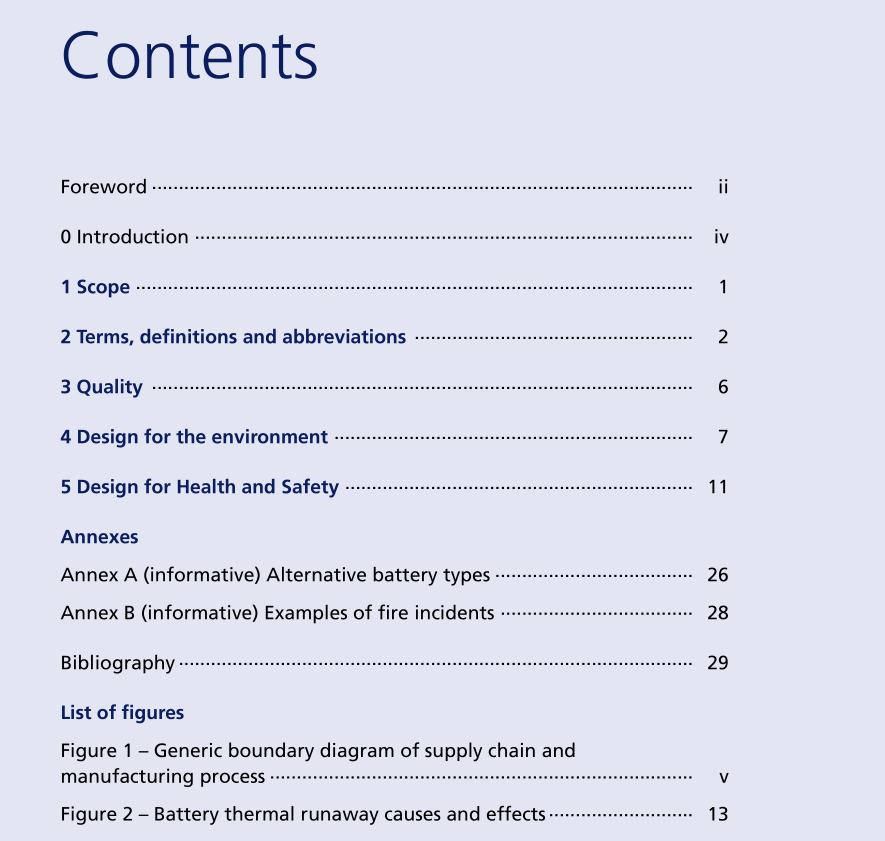PAS 7060:2021 pdf download.Electric vehicles – Safe and environmentally-conscious design and use of batteries – Guide
1 Scope
This PAS provides guidance for vehicle categories: motorcycles L1e, L2e, L3e, L4e, L5e, L6e, L7e; passenger cars M1, M2; light goods vehicles N1. NOTE 1 The vehicle categories are defned in the European Regulation (EU) No 168/2013 [1] and (EU) No 2018/858 [2]. NOTE 2 It is recommended that this PAS be used in conjunction with and be limited by the scopes of PAS 7061 and PAS 7062. This PAS gives guidance for the health, safety and environmental considerations in the process of vehicle design, battery integration and battery use for EVs and PHEVs. This PAS is intended to create effciencies in the vehicle manufacturing cycle, de-risk batteries in use, optimize re-use and recycling of vehicle batteries and ultimately improve consumer confdence in EVs and PHEVs. This PAS covers general health, safety (including fre), competency and environmental impact considerations in vehicle design and use, and provides a specifc focus on: • vehicle manufacture; • repair and recycling; • interaction with battery management systems; • mechanical and electrical integrity and isolation post- crash; • vehicle dismantling; • preparing for second life use of battery; and • health data.It does not cover vehicles other than those listed above, charging systems that do not form part of the vehicle and the health, safety and environmental requirements and considerations in the manufacture of battery cells (and electrodes), battery packs and modules which are being addressed separately. This PAS is for use by battery and automotive manufacturers. This PAS is also of interest to commercial vehicle manufacturers (M3, N2 and N3 categories), off-highway vehicle and rail vehicle manufacturers, government, regulators, insurance companies, local authorities, shipping, automotive distributors, dealerships, repairers and dismantlers and emergency services.
2.1.12 design specifcation set of requirements that are met in order for the product or process to be successful 2.1.13 dismantle to take (machine or structure) to pieces 2.1.14 electrical hazard potential source of harm when electric energy is present in an electrical installation NOTE 1 The term “harm” in this context relates to damage to either persons and/or electrical installations. NOTE 2 The electrical conditions where such a hazard occurs are when the voltage between live components is greater than 30 V ac or 60 V dc (and < 1 000 V ac or 1 500 V dc) and the short circuit current where work is being performed exceeds the value of 3 mA ac or 12 mA dc or the energy exceeds 350 mJ (source: BGI/GUV-I 8686 E [4]), or if between a live part and an adjacent dead metal part or between live parts of different polarity, there exists a potential of 2 V or more and either an available continuous power level of 240 W or more, or an energy level of 20 J or more (source: UL 478 [5]). [SOURCE: IEC Vocabulary (http://www.electropedia.org/) IEV ref 651-26-05, modifed]. 2.1.15 electrically-propelled vehicle (EV) vehicle with one or more electric drive(s) for vehicle propulsion NOTE An “electrically-propelled vehicle” includes electric vehicle (EV), hybrid electric vehicle (HEV), plug- in hybrid electric vehicle (PHEV) and fuel cell hybrid electric vehicle (FCHEV). [SOURCE: BS ISO 6469-3:2018+A1:2020, 3.15] 2.1.16 explosion sudden release of energy suffcient to cause pressure waves and/or projectiles that might cause structural and/or physical damage to the surrounding area [SOURCE: BS ISO 6469-1:2019, 3.10, modifed] 2.1.17 failure mode manner in which an equipment or machine failure can occur2.1.18 failure modes and effects analysis (FMEA) analytical procedure in which each potential failure mode in every component of a product is analysed to determine its effect on the reliability of that component and, by itself or in combination with other possible failure modes, on the reliability of the product or system and on the required function of the component; or the examination of a product (at the system and/or lower levels) for all ways that a failure may occur NOTE 1 For each potential failure, an estimate is made of its effect on the total system and of its impact. In addition, a review is undertaken of the action planned to minimize the probability of failure and to minimize its effects – see Project Management Institute, A Guide to the Project Management Body of Knowledge (PMBOK® Guide) [6]. NOTE 2 Procedure can be applied as design failure mode and effect analysis (DFMEA) and process failure mode and effect analysis (PFMEA). [SOURCE: ISO/IEC/IEEE 24765:2017, 3.1562, modifed]
PAS 7060:2021 pdf download
